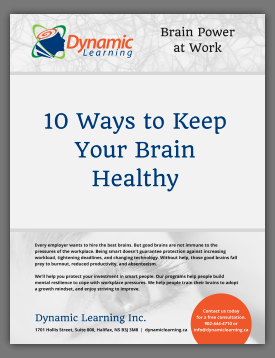While working on this article, I have become excited again about the amazing research which shows over and over again the profound effect regular exercise has on our brains.
As Alvaro Pascual-Leone, MD explains in the Harvard University Health Minute, exercise builds new brain cells and creates better brain connections. The decision-making part of the brain becomes better connected to the rest of the brain and gives us better control over our impulses. Our hippocampus, which controls our memory, produces new cells which are sent out to the rest of the brain.
John Ratey, a medical doctor and psychiatrist, wrote Spark: the Revolutionary New Science of Exercise and the Brain, in which he highlights a fitness program for 19,000 high school students in Naperville, Illinois. In 1999 Naperville Grade 8 students scored 1st in science and 6th in Math in an international standards test called Trends in Mathematics and Science, the first American students to score so high. Among one entire class of sophomores, only 3% were overweight vs. the national average of 30%.
Dr. Ratey has continued to spread the word about the importance of exercise to our brains at any age. He cites a study in Sweden where they tested 1.2 million boys at age 15. Those with greater physical fitness scored higher on IQ and other cognitive tests. When they were re-tested at age 18, those who had kept up their fitness levels had improved their IQ scores. This study included 650 identical twins. Where one twin did not maintain his fitness level and the other one did, the fitter twin actually tested with a higher IQ score than his identical twin.
Not only does exercise improve your production of brain cells and increase the connections between the cells but it is also crucial for your healthy heart, blood circulation, bone density, maintaining the elasticity in your muscles and skin, reducing aches and pain, and improving your sleep.
In my workshops, I often ask, “How many of you tell yourself you should exercise more?” Most people raise their hands. (The people who don’t raise their hands are already exercising regularly.) Our brains know that exercise is good for us, and we often promise ourselves that we will start soon, even tomorrow. But when tomorrow comes, our clever brains come up with all kinds of credible reasons why NOW is not quite the right time. To reduce the chances of talking yourself out of exercising, here are a few ideas.
Do prepare ahead of time. Know where and how you will achieve 30 minutes or more of aerobic or resistance exercise and have all the equipment you need ready to go.
Don’t expect to be “in the mood” to exercise before you start. Reassure yourself that you will be “in the mood” once you have been exercising for a few minutes – and just start.
Do make it as easy as possible. The easiest way to exercise is to build it into your daily routine at home or possibly at work. Walking briskly for part or all of the way to or from work may be an option; climbing stairs for 10-15 minutes at a time is another. Having some basic equipment at home so you can exercise while watching TV or listening to music can be the answer when the weather is unpleasant outside.
Equipment:
- Weights: 5 and 10 pound dumbbells, plus some ankle weights.
- Bicycle: If you have the space, a stationary bike can be a great way to exercise.
- A foot pedal exerciser: Takes up less space and can be used to exercise both your arms and legs; can even fit under a desk.
- A sturdy stool or block: You can step on and off.
You can design a program which works best for you by reviewing the many programs on the internet, most with clear videos on how to do each exercise. And there are apps like the 7 Minute Workout app available. A gym membership and an experienced exercise trainer can help you design a routine which will meet your precise needs.
Try to include the following types of exercise in your program:
- Aerobic exercise to increase your breathing and heart rate which sends more oxygen, glucose, and neuron-building hormones to your brain and makes your heart stronger.
- Resistance exercises which improve your muscle strength and bone density.
- Balance exercises to help prevent falls and flexibility exercises to stretch your muscles and keep you limber.
Start with 10 minutes of either aerobic or resistance exercise every other day and work up to 30 minutes at a time, 3 to 5 times a week.
Don’t tell yourself you should or must exercise more. You have probably done that before and it doesn’t work. But it does increase your anxiety around exercise. Better to remind yourself that you prefer to exercise to keep your brain as healthy as possible.
This is what you are doing for your brain every time you exercise:
- increase the growth of brain cells in your memory centre (hippocampus)
- improve blood flow and nutrition to your whole brain
- enhance your ability to learn and remember
- improve your daily mood
- delay the onset of symptoms of aging
- improve your muscle strength, bone density, heart function, balance and flexibility
About 18 months ago, I tripped while crossing a street and fell hard on one knee, causing an injury from which I am still recovering. I see it now as a blessing in disguise, although if I had been exercising more regularly it might not have happened. The blessing is that, in order to restore strength and flexibility to that injured leg, I started a regular aerobic and resistance training regime 3 times a week. That regime has improved the function of my knee remarkably well and it has also helped my memory and general health.


